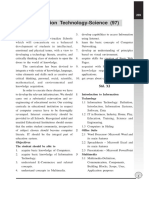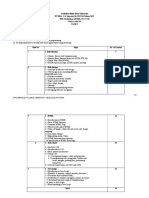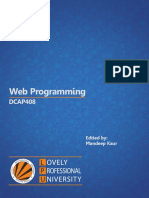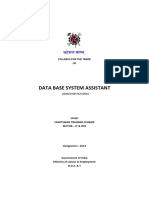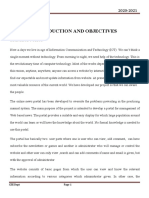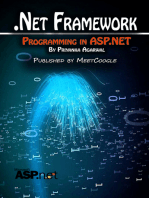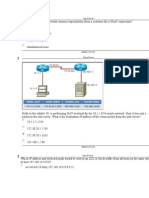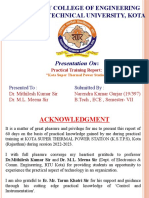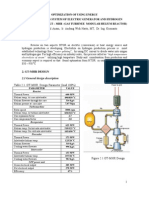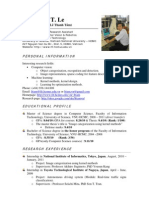h99 PDF
h99 PDF
Uploaded by
Hema fulateOriginal Description:
Original Title
Copyright
Available Formats
Share this document
Did you find this document useful?
Is this content inappropriate?
Copyright:
Available Formats
h99 PDF
h99 PDF
Uploaded by
Hema fulateCopyright:
Available Formats
248
Information Technology - Commerce (99)
Introduction 5. develop capabilities to access Information
Government has to visualize Schools using Internet
which will concentrate on a balanced 6. learn the basic concepts of Computer
development of students in intellectual, Networking
emotional and physical terms, with a view to 7. develop an understanding of principles
developing a technology literate, creative, and based on visual environment
critically thinking class of students to open the 8. acquire skills for creation of Basic Web
doors to the world of knowledge. Pages
The curriculum has been devised to 9. acquaint with basic techniques and
integrate a wide variety of knowledge, language, knowledge required for computing
value elements and skills such as creative and applications
critical thinking, personal, social, scientific, 10. get aware about cyber laws and ethics
mathematical environmental and knowledge
acquisition. Std. XI
In order to execute these dreams we have 1 Introduction to Information
to develop the relevant infrastructure. We should Technology
carry out a substantial reinvention and re- 1.1 Information Technology: Definition,
engineering of educational sector. Our existing Introduction, Information Systems,
curricula in educational institution in respect Software, Data
of computer courses have to be thoroughly 1.2 IT in Business, Industry, Home, Play,
revamped. Internet connectivity should be Education, Training, Science and
provided to all Schools. Recognized aided and Engineering
unaided Educational Institutions should ensure 1.3 Computers in Hiding
that the entire student community, irrespective 2 Office Suite
of subject chosen should become computer 2.1 Word Processor- Microsoft Word and
literate. IT should be the integral part of its main features
education system. 2.2 Spreadsheets – Microsoft Excel and
Objectives its main features
The student should be able to 2.3 Presentations – Microsoft PowerPoint
1. acquire basic knowledge of Computers 3 Multimedia
2. acquire basic knowledge of Information 3.1 Multimedia-Definition,
Technology Communication, Components,
3. understand E-Commerce and related Building Blocks, Scope, Uses,
concepts Application purposes
4. understand concepts in Multimedia 3.2 Overview of Computer Images
3.3 Digital Audio
249
3.4 Overview of Video 7 Overview of Tally
3.5 Flash – Overview and Introduction 7.1 Advantages of computerized
3.6 Multimedia Design and Future accounting
Directions 7.2 Introduction to Tally and its features.
4 Web Browsers, E-mail Clients and 8 HTML
Messenger Utilities 8.1 Uses, Features, Properties and
4.1 Overview, Working of the Internet Limitations.
and WWW 8.2 Tags and Attributes, Basic Tags
4.2 Role of Web Servers, Clients Paragraph and Heading Tags,
4.3 Web Browsers and their use, Popular Comments
Web Browsers 8.3 Ordered and Unordered Lists and
4.4 E-Mail Servers and Protocols Related Tags, Nested Lists
4.5 E-mail Clients and Web Based Mail 8.4 Anchor Tag and Hyperlinks in HTML
Access using Browser 8.5 Division and Physical Style Tags,
4.6 Messenger Services and Clients working with Fonts, font types, sizes
4.7 FTP and colours.
5 File and Disk Utilities 8.6 Body background colour, text colour
5.1 Concept of Files and directories and hyperlink colours, Pre-formatting,
5.2 File Archival, compression and Line Break, and Horizontal Rules,
encryption Displaying special characters in
5.3 Disc Tools (Windows 7) Error- HTML
Checking and Defragmentation 8.7 Images in HTML, related tags and
5.4 Computer Security attributes, features of BMP, JPG and
6. Basic Database Concepts GIF Raster image formats
6.1 Definition of Database and database 8.8 Tables in HTML and related tags
program 8.9 Marquee
6.2 Tables, Rows/Records, Columns/ 8.10 Java Applets
Fields, Differences between database
and spreadsheet Std. XI - Practical List
6.3 Relational abilities and meaning of 1. Identification of Computer Systems and
Relational Database understanding LAB setup.
6.4 Basic Concepts of database and 2. Exercise on Windows, Start Menu and
RDBMS Accessories.
6.5 Constraints to ensure data quality 3. Creating Documents, page formatting, use
6.6 Database Administration, Software of fonts and colour and printing using
Development, Business Analysis Word
6.7 SQL, History and Command 4. Mail merge and envelope printing using
Categories Word
250
5. Study of Spreadsheet using Excel 2 Cyber Laws and Ethics
6. Create simple Presentation and Slideshow 2.1 Moral, Ethics and Law
using PowerPoint 2.2 Ethics Culture and ethics for computer
7. Practical on simple Flash based animation users, professionals and business
8. Study of a Web Browser for browsing 2.3 Information Service
different websites 2.4 Code and guidelines of ethics
9. Acquisition of e-mail ID on free web- 2.5 Introduction to cyber laws and IT Act
based e-mail servers; sending and receiving of India 2000
emails with and without attachments. 2.6 Digital Signature, Electronic Records-
10. Study and use of search engines and Attribution, acknowledgement and
messengers. dispatch.
11. Downloading and saving Web page content 2.7 Ten Commandments of Computing
and images as files. 2.8 Security, Privacy and Control
12. Creation of Compressed File Archives ZIP 2.9 Intellectual Property Rights
and RAR 3 E-Commerce
13. Study of Disk Management Tools 3.1 Electronic Commerce-Scope,
14. Create a simple web page using basic Definition
HTML tags. 3.2 Trade Cycle
15. Creation of WEB page containing graphics 3.3 Electronic markets-Usage, Advantages
and table. and Disadvantages, Future
16. Use of Hyperlinks on web pages. 3.4 Electronic Data Interchange-
17. Creating simple database, table, forms and Definition, Benefits
reports using Access. 3.5 Internet Commerce, e-Commerce in
18. Generating simple queries and verifying Perspective
results. (Access). 3.6 EDI Security
19. Study of TALLY Package (GATEWAY) 4 Introduction to Networking
4.1 Communication and Network
Std. XII Technologies
4.2 Internet, Network Communication and
1 Web Publishing Protocols
1.1 HTML Page Frames 4.3 Transmission Media,
1.2 Image Mapping Communication over Wires and
1.3 Forms and Form Objects Cables, Wireless Communication
1.4 Inserting Sound and Video and Standards
1.5 Use of Unicode and Indian Language 4.4 Network Architecture,
Fonts Relationships and Features
1.6 Cross-Browser Testing 4.5 Cable Topologies
1.7 Introduction to CSS 4.6 Network Hardware
1.8 Web Server 5 Data Management using Access
251
5.1 Microsoft Access and its main 6. Use of Video on Web Pages
features, Database Concepts 7. Creation and Publishing a Website using
5.2 Opening existing Databases FTP
5.3 Working with Tables 8. Cross Browser Testing and Differences in
5.4 Introduction to Forms and working Rendering
with forms 9. Creation of Webpage in Devnagri Script
5.5 Table Relationships (one-to-one and (Marathi or Hindi) using UNICODE. Use
many-to-many) Queries, Query types, MS-Word with BarahaIME and Save as
creation of Query manually as well as html
using wizard, calculations using 10. Conversion between Audio File Formats
queries (based on Std. XI syllabus)
5.6 Introduction to Reports and working 11. Image Conversion between Image file
with Reports formats (based on Std. XI syllabus)
6 Tally
6.1 Creating and configuring Company
Menus related to Accounts
6.2 Working with Groups and Ledgers
6.3 Study of Cost centers and Vouchers
6.4 Printing Purchase orders, Sales orders
and Invoice
6.5 Study of Trial Balance, Balance Sheet
and Profit and Loss Account
Practical List
1. Creation of a Website
2. Creation of a Website with Frames and
CSS
3. Hyperlinks on a Web Page using Client
Side Image Mapping
4. Hyperlinks on a Web Page using Server
Side Image Mapping
5. Use of Audio and Animation on Web
Pages
You might also like
- Wassce / Waec Information and Communication Technology (Elective) SyllabusDocument4 pagesWassce / Waec Information and Communication Technology (Elective) SyllabusSamuel Aikins100% (1)
- Dcap202 Fundamentals of Web ProgrammingDocument178 pagesDcap202 Fundamentals of Web ProgrammingMuhammad Yusif AbdulrahmanNoch keine Bewertungen
- Concorde Battery Component Maintenance ManualDocument40 pagesConcorde Battery Component Maintenance Manualrav0% (1)
- OJT CorrigidoDocument77 pagesOJT CorrigidoDiomacio Apolinario da SilvaNoch keine Bewertungen
- Information Technology-Science (97) : NtroductionDocument5 pagesInformation Technology-Science (97) : NtroductionAnand ChineyNoch keine Bewertungen
- 1543402776final Computer Science 9-12 LisenceDocument11 pages1543402776final Computer Science 9-12 LisenceRaj Kumar ShresthaNoch keine Bewertungen
- A Lesson in Applcn SW An Erlrng ExmplDocument38 pagesA Lesson in Applcn SW An Erlrng ExmplShainu MathewNoch keine Bewertungen
- Information and Communication Technology ElectiveDocument3 pagesInformation and Communication Technology Electivekrame.orgNoch keine Bewertungen
- BCS Higher Education Qualifications Diploma in IT Principles of Internet Technologies SyllabusDocument5 pagesBCS Higher Education Qualifications Diploma in IT Principles of Internet Technologies SyllabusRich AremogNoch keine Bewertungen
- Information and Communication Technology CoreDocument3 pagesInformation and Communication Technology CorebamiseexcelNoch keine Bewertungen
- Lydiah Comp NotesDocument99 pagesLydiah Comp NotesKin B Simiyu100% (2)
- Computer Science XIIDocument48 pagesComputer Science XIIPrem RajwanshiNoch keine Bewertungen
- Computer Science (Optional II) Grade 9-10: Micro Syllabus - Academic Year 2069Document6 pagesComputer Science (Optional II) Grade 9-10: Micro Syllabus - Academic Year 2069Cricket WorldNoch keine Bewertungen
- New Format Syllabus For College of Business AdministrationDocument20 pagesNew Format Syllabus For College of Business AdministrationEdison F. CasumpangNoch keine Bewertungen
- BSC CSIT 7th Semester SyllabusDocument19 pagesBSC CSIT 7th Semester SyllabusFiroj GhimireNoch keine Bewertungen
- T3217-Fundamentals of ITDocument5 pagesT3217-Fundamentals of ITHarshita KhemkaNoch keine Bewertungen
- Web Tech Quantum UpdatedDocument204 pagesWeb Tech Quantum Updatedanimehv5500Noch keine Bewertungen
- 1 - Course Description & Outline - Introduction To ICTDocument5 pages1 - Course Description & Outline - Introduction To ICTMaira amanNoch keine Bewertungen
- NEB Computer SyllabusDocument9 pagesNEB Computer SyllabusSrijana PaudelNoch keine Bewertungen
- Syllabus of MCA - Management - 2020 Patt - Sem III and IV - 13122021Document23 pagesSyllabus of MCA - Management - 2020 Patt - Sem III and IV - 13122021HIRAL PATELNoch keine Bewertungen
- Computer Fundamentals SyllabusDocument8 pagesComputer Fundamentals SyllabusJudith JanerNoch keine Bewertungen
- CCC SyllabusDocument3 pagesCCC SyllabusLearn TechNoch keine Bewertungen
- Teaching Plan: Niversiti Utra AlaysiaDocument3 pagesTeaching Plan: Niversiti Utra AlaysiaFizz FairuzNoch keine Bewertungen
- 11 20CMO No. 25 S. 2015Document10 pages11 20CMO No. 25 S. 2015lea contigaNoch keine Bewertungen
- Internet Technology and Web DesignDocument3 pagesInternet Technology and Web Designali_zulfikar100% (4)
- Cambridge International As & A Level 9618 Computer Science Syllabus For Examination in 2024 and 2025Document20 pagesCambridge International As & A Level 9618 Computer Science Syllabus For Examination in 2024 and 2025Om Parkash Sarwan Bheel100% (1)
- Advanced PHP and Mysql: Course SyllabusDocument8 pagesAdvanced PHP and Mysql: Course SyllabusAbc100% (2)
- Table of ContentsDocument3 pagesTable of ContentssvandiambalamacomNoch keine Bewertungen
- Oxfordian College: I. Course InformationDocument6 pagesOxfordian College: I. Course InformationLiza MambiarNoch keine Bewertungen
- Introduction To ComputingDocument1 pageIntroduction To Computingapi-26365311Noch keine Bewertungen
- STID1103 SYLLABUS A211 StudentDocument5 pagesSTID1103 SYLLABUS A211 StudentLi XuanNoch keine Bewertungen
- IWP SyllabusDocument5 pagesIWP Syllabuspankaj manglaNoch keine Bewertungen
- Course TitleIntroduction To Information Technology ICT ED. 415Document9 pagesCourse TitleIntroduction To Information Technology ICT ED. 415kripaaanja321Noch keine Bewertungen
- Informatica MDM Course ContentDocument4 pagesInformatica MDM Course ContentMudavath RajuNoch keine Bewertungen
- Allama Iqbal Open University, Islamabad Warning: (Department of Business Administration)Document6 pagesAllama Iqbal Open University, Islamabad Warning: (Department of Business Administration)AreebaNoch keine Bewertungen
- Computer ApplicationsDocument217 pagesComputer ApplicationsBIROI GODFREYNoch keine Bewertungen
- 13 Sppu/Bba (Ca) Syllabus Semester-Ii Cbcs/2019 PatternDocument3 pages13 Sppu/Bba (Ca) Syllabus Semester-Ii Cbcs/2019 Pattern3427 Sohana JoglekarNoch keine Bewertungen
- IT160 Intro To Information TechnologyDocument3 pagesIT160 Intro To Information TechnologyitxkazimNoch keine Bewertungen
- Dcap408 Web ProgrammingDocument321 pagesDcap408 Web ProgrammingmartinNoch keine Bewertungen
- CCC PDFDocument6 pagesCCC PDFGhanshyam SharmaNoch keine Bewertungen
- Universiti Utara Malaysia School of ComputingDocument4 pagesUniversiti Utara Malaysia School of ComputingSyafiqah AzizanNoch keine Bewertungen
- DBM 612 Business Information SystemsDocument4 pagesDBM 612 Business Information SystemsobaladermottNoch keine Bewertungen
- Integrative ProgDocument3 pagesIntegrative ProgDagneWalleNoch keine Bewertungen
- Fundamental of ComputerDocument5 pagesFundamental of ComputerAshok MundeNoch keine Bewertungen
- Integrative ProgDocument5 pagesIntegrative ProgRicHArdNoch keine Bewertungen
- EOS Web and Multimedia L3Document53 pagesEOS Web and Multimedia L3ብርሃነ ኣፅብሃNoch keine Bewertungen
- Introduction To Informaiton Technology Express Learning by ITL Education Solutions LimitedDocument409 pagesIntroduction To Informaiton Technology Express Learning by ITL Education Solutions LimitedPrince kumarNoch keine Bewertungen
- Ajp Tyif (9165)Document14 pagesAjp Tyif (9165)api-3728136Noch keine Bewertungen
- MCSL-016 Block-1 PDFDocument174 pagesMCSL-016 Block-1 PDFVenkataramanan SureshNoch keine Bewertungen
- Information Communication Technology E SampleDocument4 pagesInformation Communication Technology E SampleregeriaNoch keine Bewertungen
- Advertisement For ABCDocument13 pagesAdvertisement For ABCkishan.aditya2021Noch keine Bewertungen
- DigiTitans 6Document42 pagesDigiTitans 6May ArucanNoch keine Bewertungen
- Course Outline For RadiologyDocument6 pagesCourse Outline For Radiologysyed Arshad aliNoch keine Bewertungen
- Computer Literacy Clt-101 Course OutlineDocument3 pagesComputer Literacy Clt-101 Course Outlinekwofieabigail61Noch keine Bewertungen
- Wassce / Waec Information and Communication Technology (Core) SyllabusDocument4 pagesWassce / Waec Information and Communication Technology (Core) SyllabusSamuel AikinsNoch keine Bewertungen
- Allama Iqbal Open University, Islamabad Warning: (Department of Business Administration)Document5 pagesAllama Iqbal Open University, Islamabad Warning: (Department of Business Administration)WasimNoch keine Bewertungen
- Data Base System Assistant: Syllabus For The Trade OFDocument17 pagesData Base System Assistant: Syllabus For The Trade OFniyaNoch keine Bewertungen
- Introduction To Computer Get Connected Scope and Sequence2Document4 pagesIntroduction To Computer Get Connected Scope and Sequence2Tshepo TshabalalaNoch keine Bewertungen
- Project Report DbmsDocument22 pagesProject Report DbmsArshad HussainNoch keine Bewertungen
- Designing A Banking SystemDocument47 pagesDesigning A Banking SystemFarooq KhanNoch keine Bewertungen
- Linux System Programming: From Basics to Expert ProficiencyFrom EverandLinux System Programming: From Basics to Expert ProficiencyNoch keine Bewertungen
- BC237 MotorolaDocument3 pagesBC237 MotorolaTomas VillacresNoch keine Bewertungen
- DEE Brochure 16Document20 pagesDEE Brochure 16GabrielNoch keine Bewertungen
- Ccna 4 - Final ExamDocument7 pagesCcna 4 - Final ExamaubhieNoch keine Bewertungen
- Numerical Investigation of Combustion Optimization in A Tangential Firing Boiler Considering Steam Tube OverheatingDocument15 pagesNumerical Investigation of Combustion Optimization in A Tangential Firing Boiler Considering Steam Tube OverheatingYogesh DewangNoch keine Bewertungen
- Fermentor Scale UpDocument18 pagesFermentor Scale UpbabuvividNoch keine Bewertungen
- Training Report KTPS - NGDocument24 pagesTraining Report KTPS - NGHarsh DungarwalNoch keine Bewertungen
- Brewery Effluent Treatment Plant (ETP) PerformanceDocument7 pagesBrewery Effluent Treatment Plant (ETP) PerformanceMohan P100% (1)
- THF DistillationDocument3 pagesTHF Distillationbloggsjoe1970Noch keine Bewertungen
- SurveysDocument5 pagesSurveysVier Eli Dakiwag BusligNoch keine Bewertungen
- 03 - E-10 - Hazirin Safrian Utama - Fandilla Dimas PrayogaDocument3 pages03 - E-10 - Hazirin Safrian Utama - Fandilla Dimas PrayogaHazirin Safrian UtamaNoch keine Bewertungen
- 06a Memory v2Document11 pages06a Memory v2Vincent Terra NovaNoch keine Bewertungen
- Tehnicke Karakteristike Asistal Alu OkapnicaDocument2 pagesTehnicke Karakteristike Asistal Alu OkapnicaDARKO RADICEVICNoch keine Bewertungen
- LogcatDocument118 pagesLogcatsaidfadhlurNoch keine Bewertungen
- Digispec Proximity/Zero Speed HF Sensor: SpecificationsDocument2 pagesDigispec Proximity/Zero Speed HF Sensor: SpecificationsBayanaka TehnikNoch keine Bewertungen
- National Standard For Commercial Vessels: Australian Transport CouncilDocument26 pagesNational Standard For Commercial Vessels: Australian Transport CouncilCarl FranksNoch keine Bewertungen
- Fast EvoDocument64 pagesFast Evogti54726Noch keine Bewertungen
- 001 Vol 01 Sec 01Document94 pages001 Vol 01 Sec 01Jorgelina DiazNoch keine Bewertungen
- Hydrogen Production With GT - MHRDocument5 pagesHydrogen Production With GT - MHRAnam AkhmadNoch keine Bewertungen
- Product Navigator SEGDocument4 pagesProduct Navigator SEGkacemNoch keine Bewertungen
- Tutorial 3 - SolutionDocument5 pagesTutorial 3 - SolutionHIMANSHU VERMANoch keine Bewertungen
- CV TamLe 11juneDocument3 pagesCV TamLe 11juneTam T. LeNoch keine Bewertungen
- Problem 1. Plot The Hydrograph For The Storm Data Given On The Table (Flow Rate VsDocument8 pagesProblem 1. Plot The Hydrograph For The Storm Data Given On The Table (Flow Rate VsRodilyn BasayNoch keine Bewertungen
- Truba Company ProfileDocument20 pagesTruba Company ProfileRagerishcire KanaalaqNoch keine Bewertungen
- Acids and BasesDocument38 pagesAcids and Basesapi-285760019Noch keine Bewertungen
- UET Research Proposal Template Final VersionDocument9 pagesUET Research Proposal Template Final VersionHabibUllahNoch keine Bewertungen
- MLM Software Project ManagementDocument22 pagesMLM Software Project ManagementranjinirameNoch keine Bewertungen
- Naca 4412Document3 pagesNaca 4412Selva KumarNoch keine Bewertungen
- Seminar On Pre-Engineered Metal Buildings BY Kavitha Maharaj M.Tech. (P.T.P.G) 5 SemesterDocument38 pagesSeminar On Pre-Engineered Metal Buildings BY Kavitha Maharaj M.Tech. (P.T.P.G) 5 Semestermaheshbandham100% (1)




